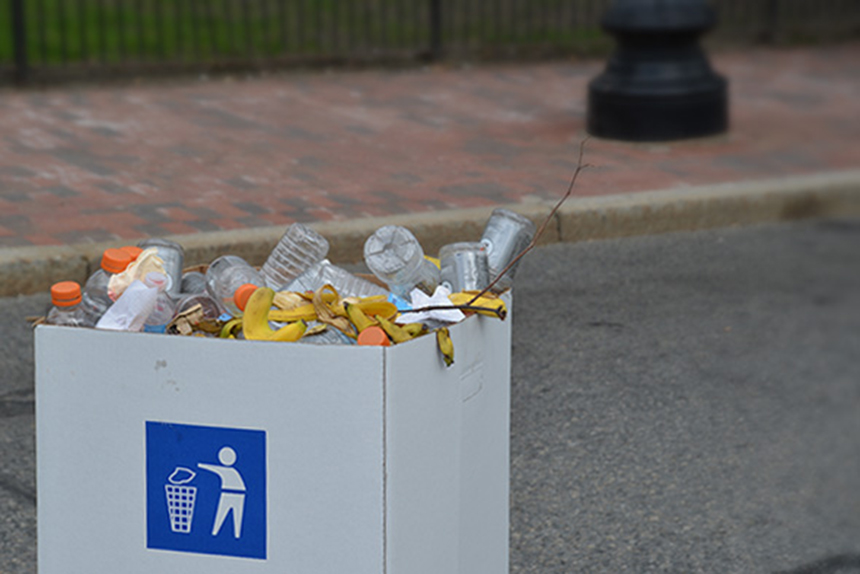NYC Adopted Composting. Why Can’t Rhode Island?
February 19, 2018
It only took three years for New York City, with a population of 8.5 million, to launch a comprehensive composting program for homes, businesses, and schools. Why can’t Rhode Island, with 1.2 million people and more space for composting, do the same?
Here’s how New York City did it. For several years, environmental groups and plucky residents ran sanctioned and unofficial composting sites on city land. Food-scrap drop-off sites opened at farmers markets, parks and outside subway stations.
In 2013, seeing composting as an opportunity to address climate change, Mayor Michael Bloomberg championed a citywide program as one of his final initiatives in office. Composting curbs greenhouse-gas emissions and saves money by reducing the amount of waste trucked and shipped by rail to landfills, which costs the city about $105 a ton.
To encourage more composting, the New York City Council passed two laws to launch residential food-scrap collection and guidelines for diverting commercial waste from landfills. There were skeptics, even in the environmental community, who envisioned neglected piles of smelly, rotting food.
However, with funding from the city’s Department of Sanitation, groups such as GrowNYC and the Lower East Side Ecology Center taught classes on sustainability and composting to residents in their respective boroughs. As part of the NYC Compost Project, each group organized drop-off locations and managed a composting yard. First-time compost participants completed online training before receiving a pass code to bins at the drop-off sites.
Meanwhile, the sanitation department launched a separate program for curbside collection with a neighborhood in Staten Island and 100 schools as the first participants. A new brown bin joined the recycling and trash bins. The toters were emptied by trucks already collecting leaf and yard waste. Municipal employees managed the program and worked out any snags. Initially, the food scrap was sent to two composting sites and one anaerobic digester within the city.
Even though New York had a poor recycling rate, it was still able to make room for food-scrap diversion in its waste management program. The Staten Island collection reached a respectable 43 percent participation rate, with a contamination rate of less than 1 percent.
New neighborhoods, schools and high-rise apartments were added to the curbside program. As of the end of 2017, curbside collection reached 3.3 million New Yorkers. The drop-off program reached a collection milestone of 10 million pounds in December. By the end of 2018, all residents are expected to have access to municipal curbside collection or drop-off sites.
Progress continues under Mayor Bill de Blasio, who launched the next goal: Zero Waste Challenge. The program is underway at several public schools. In addition to composting and aggressive recycling, the aim is to eliminate waste by 2030 through reuse programs, pay-as-you-throw trash collection and greater recycling of textiles and electronics.
Why not Rhode Island?
Rhode Island delivers more than 1 million tons of trash annually to the Central Landfill, or about a tenth of New York City’s waste.
Compost enthusiasts have called for statewide food-scrap collection and composting for the 300,000 tons of food scrap and organics Rhode Islanders throw away every year.
Neighborhood drop-off sites are scattered around Providence and elsewhere in the state. Providence briefly ran a food-scrap collection program until funding ran out. A handful of private residential food-scrap collection companies serve Providence and parts of Pawtucket and Cranston.
A 2014 state law established a timetable for food-scrap diversion by large food businesses such as supermarkets, food manufacturers and hotels. Edible food can be donated to a food pantry or diverted to a farm, compost facility or anaerobic digester.
The Compost Plant and a few trash haulers are running food scrap from these institutions to the state’s only commercial composting site, Earth Care Farm in Charlestown.
An anaerobic digester is nearing completion in Johnston, less than a half a mile from the Rhode Island Resource Recovery Corporation, the manager of the state’s primary landfill. The digester’s two 2.5-million gallon tanks have the capacity to process a sizable share of the state’s food scrap and organic material, while generating electricity and a soil amendment.
While some Rhode Island schools and businesses compost and manage their food waste, there is no campaign to advance municipal composting for residents or businesses. A legislative study commission is reviewing food recovery and donation ideas. The commission was expected to submit a report to the House of Representatives by March 7, one day before the annual Compost Conference & Trade Show in Providence. The commission, however, has requested an extension until June 28.




Excellent article! I will lead a workshop on this topic at the Compost Conference on March 8. I hope to see you there.
Everyone interested should come to the compost conference on March 8 at RIC. Check out environmentcouncilri.org for details.